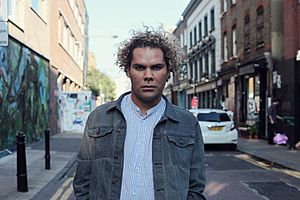Christian Thompson (artist) facts for kids
Quick facts for kids
Christian Thompson
|
|
|---|---|
 |
|
| Born |
Christian Andrew William Thompson
1978 (age 46–47) |
| Nationality | Australian |
| Education | University of Southern Queensland, Royal Melbourne Institute of Technology, University of Oxford |
Christian Andrew William Thompson AO, who also uses the name Christian Bumbarra Thompson, is a famous modern Australian artist. He was born in 1978. His father's family is of Bidjara heritage, an Aboriginal Australian group. This identity is a very important part of his art.
Thompson creates art using photography, video installations, and sound recordings. He was one of the first Indigenous Australians to study at the famous University of Oxford in England. He earned a scholarship to get his doctorate degree there. His amazing artwork has been shown in galleries all over Australia and around the world.
Contents
Early Life and Education
Christian Thompson was born in Gawler, South Australia. He has a rich and diverse background. On his father's side, he has Bidjara and Chinese Australian heritage. He also has Irish, Norwegian, and Sephardic Jewish ancestors. His great-great-grandfather was a respected Bidjara leader named King Billy of Bonny Doon Lorne.
Because his father was in the Royal Australian Air Force (RAAF), Thompson's family moved around a lot when he was a child. He lived in many places, including Darwin and Wagga Wagga. He spent his holidays in Barcaldine, where he learned about the culture and traditions of his people from his grandmother and great aunts.
Becoming an Artist
Thompson grew up in a creative family and was encouraged by his art teacher. He decided to study art and earned his first degree from the University of Southern Queensland. He then moved to Melbourne to continue his studies at the Royal Melbourne Institute of Technology.
During his studies, he was inspired by artists like Andy Warhol and Yoko Ono. He also loved the music and culture of the 1980s and '90s, especially punk music.
Studying at Oxford
In 2010, Thompson received a special award called the Charlie Perkins Scholarship. This allowed him to study for his doctorate in Fine Art at the University of Oxford. He and one other student were the first Indigenous Australians to ever attend Oxford.
Living and studying in England and other parts of Europe gave him a wider view of the world, which influenced his art.
Artistic Career
At the start of his career, Thompson explored how to use the human body in his art. He later began using photography and video to show off his amazing sculptures and detailed costumes.
One of his first famous works was a series of photos called Blaks Palace, which featured giant sweaters. His art often explores the idea of identity and how it can change and grow. He mixes different ideas and styles to create something new and exciting.
Exploring Sound and Language
Thompson also creates art with sound. He is interested in the natural, song-like quality of his traditional Bidjara language. He mixes traditional rhythms with modern music to create unique sound pieces.
One of his most famous video works is called Dhagunyilangu, which means "brother." In the video, a British opera singer performs a song that Thompson wrote in the Bidjara language. This language was almost lost, but artists like Thompson are helping to bring it back. He said that seeing how this artwork affected other people was one of the most rewarding parts of his career.
In 2019, he created his first virtual reality (VR) project called Bayi Gardiya (Singing Desert). In this VR experience, Thompson sings in the Bidjara language, bringing the viewer into a beautiful and ancient world.
Exhibitions and Recognition
Thompson's art is very popular and is held in many important collections. You can find his work in the National Gallery of Australia, the Art Gallery of New South Wales, and the Queensland Art Gallery. His art is also owned by international museums and private collectors, including the actress Cate Blanchett.
He has shown his work in major art events like the Biennale of Sydney and the Adelaide Biennial of Australian Art. In 2018, a large exhibition called Ritual Intimacy toured Australia, showing a survey of his work from over the years.
Major Awards
Thompson has received many awards for his incredible contributions to art.
- 2010: He was awarded the first-ever Charlie Perkins Scholarship to study at the University of Oxford.
- 2017: He received the first Mordant Family VR Commission from the ACMI to create his VR artwork.
- 2018: He was made an Officer of the Order of Australia, a very high honor, for his amazing work as an artist and for being a role model for young Indigenous artists.
- 2020: He won the Bowness Photography Prize for a work titled "Rule of three."

